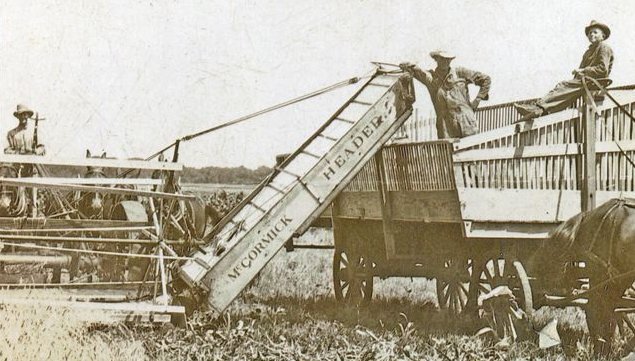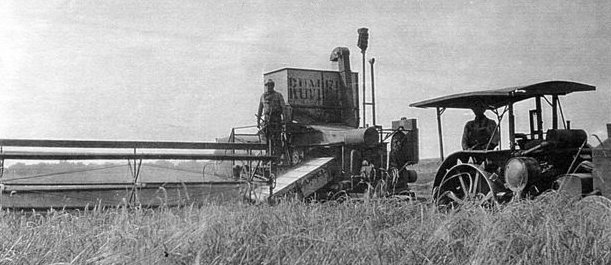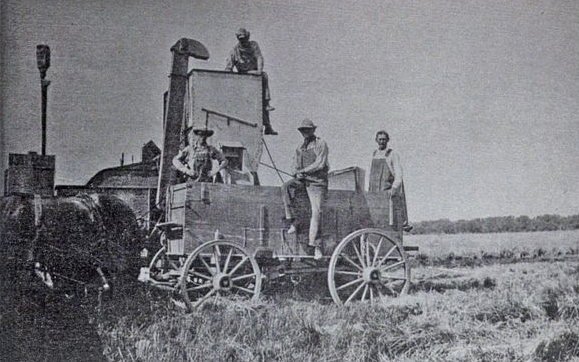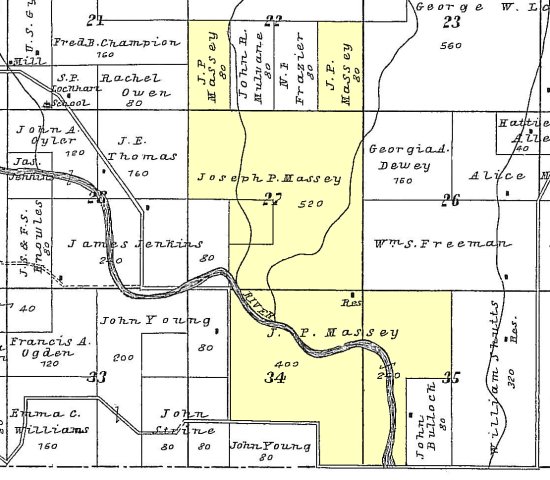E-mail from David Massey to Jerry Ferrin, 29 January 2007.
Hi, Jerry,
I hate to act like I am an authority on farming in the threshing
machine era because there was very little of it going on when I was old
enough to remember, but there was some.
The last fellow that I remember who
had a threshing machine was a fellow by the name of Shipley, I believe, and I
am not sure where he was from. It was probably in 1941 or '42 and he
threshed for Uncle Marion (McLain) and Randolph Stone who was farming the Bibbs place. My cousin, Red Hunter, had the job as water boy and had got
sick. Uncle Marion came out to the place to borrow me until Red was on his feet and was I pleased, not that Red was sick, but that it was a paying job
- usually when a boy was borrowed there was no money involved - the pay was 50
cents per day.
Did I ever make a hand, I nearly ran that little old short-legged horse into the ground carrying those 2 & 3 gallon crock jugs from one crew to the other. Red got back on his feet after awhile and took his job back and I eagerly waited until the end of threshing for pay day. I don't know how many ways I spent that money but... pay day came and went and no one offered to pay me.
It was a little confusing. Uncle Marion hired me, but it was for Mr. Shipley who was threshing for Mr. Stone. I was so timid I didn't have enough nerve to ask anyone. All I would have had to have done was to mention it to Uncle Marion and it would have been taken care of, but then I wouldn't have had a story to tell, would I?
What I started to tell was what is shown in the picture is a header as
opposed to a threshing machine. Prior to the "Header" the wheat was all
bound and placed into shocks until such time as the Threshing Machine would
get to your place. Then, obviously, when the thresher arrived the bundles
were picked up and hauled to the thresher (some of the old timers called it a
seperator) where the grain was threshed and the straw was blown into a
stack. Then the header came along and cut out one operation, the shocking.
If you will notice in the picture the header was pushed by the mules and
the sickle that cut the wheat and the reel that pushed it into the sickle
were both ground-driven, this was elevated into that wagon shown, hauled and
placed in stacks, and the thresher was pulled in next to the stacks and the
wheat was pitched in. Quite a labor saver, that header wasn't it.
The Massey family never did have a threshing machine. The local threshers were Ora
Adams and Frank Harrington. There may have been more but I have visited
with each of these fellows about those old threshing days and marvel that
the farmers of yesteryear survived to middle age.
The old Rumley combine was used up until the early 40's. It was powered by a big old Continental motor and pulled by the old Rumley tractor at about slow walking speed. I
don't remember anything about the old tractor except that it was obviously
very much underpowered as it sat at the foot of the hill Nate mentioned until the scrap drives of WWII.
The old machinery was very unreliable and I can remember that Dad and Uncle Ray spent a lot of time "mechanicing "on those old machines. Both of the "boys" were pretty laid back and did not
excite too easily and were careful of their language around the youngsters
and the opposite sex; however, I can recall one time when the old Model D
"Johnny Popper" failed on them.
The temperature was high and they had the cover off the gear box, Uncle Ray dropped a nut or bolt and it went all the way to the bottom, who knows where, but certainly under all the gears and in several gallons of 140W transmission oil.
Though I grew up around up around cow-boys, "done a hitch in the Navy", worked in the oil-field, gyp-mine, and prisons, I never heard anyone express their frustrations any more eloquently
and at such length as he did that day. Dad got tickled and after awhile Uncle Ray did too, but on that day little David learned something about the art of serious "cussing".




